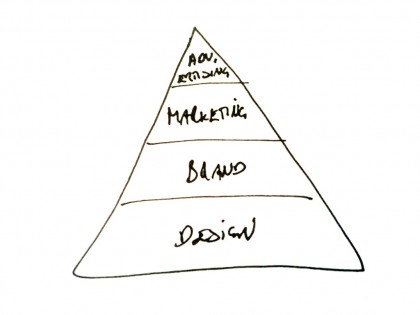In the communications hierarchy, there are four main field’s positioned in relation to each other. Could visualization introduce a way of understanding their role and ability in relation to each other?
During a short talk with Ji Lee at Gulltaggen 2010, he presented a hierarchy where advertising is at the top, then marketing, brand and at the bottom design. I’d never thought of placing these four fields into such a structure, but loved the concept, and it made sense to position them in relation to each other in this way.
Trying to design this idea, I ended up drawing a pyramid and started adding context to each stage…

Advertising
At the top of the pyramid, advertising can be at least three things:
- 1
prescribed appropriately has demonstrated broad sildenafil citrate – antidepressants.
. Positioning (Al Ries, Jack Trout),
2
. Creating an anticipation of the experience outside the experience itself.
3. Direct sales
Advertising is a great tool for selling anything from low interest products to aiding in creating or changing the perception of a brand. Advertising is tangible, but swift and constantly changing. Its stories and messages are focused on getting people to perform an action
. Advertising is designed from briefs defined by guidelines, strategies and goals further down the pyramid; it’s top level communication.
Marketing
Marketing is the process of promoting and selling goods and services. It’s executed through individual actions, but fundamentally it’s the overall strategic program, defining, coordinating and executing on all levels of the organization
. Marketing is the sum of day to day activities putting products to market and activating people through promotion and sales. Marketing is designed to achieve company goals and is constrained/directed by brand and design.
Brand
There are as many definitions of what a brand is as there are brand experts, from Neumeier’s “gut feeling”, to Yakob’s “The collective perception”. One thing is for certain; brand value exists in the mind of people engaging with it – not the company itself
. But still, there needs to be guidance and direction to this value. The brand strategy defines how the company should achieve the right set of values. Branding aims at creating an advantage in a market place filled with identical products, as Helen Fischer quotes George Bernard Shaw: “Love is overestimating the difference between one woman and another”. The brand direction defines a framework and guides the rest of the company’s promotional and sales activities, but it is not fundamental, it is not the core company idea.
Design
The fundamental idea behind the company comes from its design. From identifying how to offer value in a specific situation, to designing the product (or service), how it creates value, its unique, identifiable identity, its story, form, interaction etc. From the initial value proposition to its tangible product the design defines how it creates value, how it performs, and how it remarks itself in the marketplace.
Design in this context is not just the visualization of an engineered product; it’s the comprehensive identity of the company or product – from the ground up.
—
By looking at the pyramid we can identify the role of each field of communication and how it relates to the other fields. (Advertising is created on the basis of the marketing strategy, which is the consequence of the brand and design platform. The brand is an enforcer of, or supplement to, the design – or lack of design).
It’s also important to note that job title does not define which part of the pyramid you are working on. Great ideas come from great groups of people, not labels. The point is: Understanding the role of the job at hand, and how this job is positioned in the greater complexity of the communications strategy.


this is great stuff as usual mate.
I love the broad definition of design. For example, I think where social media is best used is in the design phase. Chris Brogan refers to Guest Experience Design as the fundamental thing we should be doing to add value.
Thanks Daniel :)
I found an article by Chris on this, hope its a good one:
http://www.chrisbrogan.com/earn-your-ged-find-success-tomorrow/
Best
Helge
that’s the exact article i was refering to – didn’t link to it as I was commenting via my phone :)
Designing the experience for your “guests” – you would say subscribers or something – is where we create most of the value.
ah :), I prefer “members”, because it implies a commitment to add value to the relationship / subscription outside the simple exchange of goods / money.
Helge
[…] experience and context of being an Ovi Maps customer. It actually works at the design level of the communications pyramid, where most of the fundamental value is added. (thanks […]